Proper Probe Placement in Your Turkey
Thanksgiving is one of the most food-centered days of the year, and just about the only time for a Turkey to shine. In this post, we’ll help you with one of the key principles of turkey cooking that you need to get a perfect bird this year!
While you can find any number of turkey recipes with varying methods and flavors they all have one thing in common: making sure your turkey is properly cooked. And the thermal principles that we talk about here for cooking your turkey are applicable to any recipe.
Not Just One Thermometer

One thermometer is just not enough for perfectly cooked turkey. You need an oven-safe leave-in probe thermometer to track the temperatures during the cook and an instant read thermometer to verify doneness at the end. And to ensure that your leave-in thermometer is doing its job correctly, you need to make sure that your probe is in the right place.
The First Step: Accurate Probe Placement
For best results, insert your thermometer’s oven-safe probe ( a DOT® with a Pro-Series® probe) into the deepest part of the turkey breast, avoiding bone. You want an even layer of meat above and below the probe so that it’s evenly surrounded by the meat.
Avoiding bones is important because bone has different thermal properties than meat. A probe resting against a bone will not give an accurate temperature reading for the meat itself. Plus the bones are not in the thermal center of the bird.
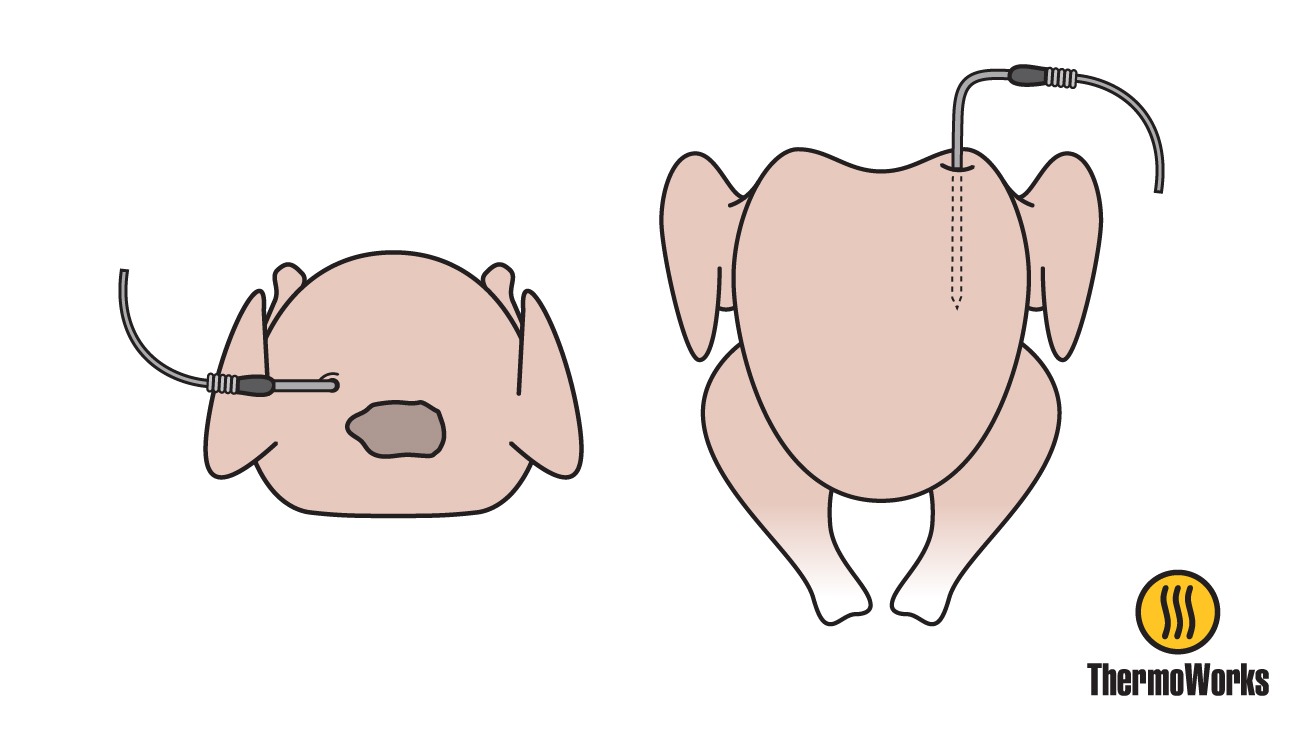
How to Place the Probe
Insert the probe horizontally, from near the neck cavity.
- The probe’s tip should be about 1/2 to 1 inch (1.3 to 2.5 cm) from the internal cavity of the bird to avoid touching the bone.
With the probe in place, you’re ready to track the breast’s internal temperature during the cook. Remember that breast and leg meat should cook to different temperatures, but breast is the one that will dry out if overcooked. So make sure you temp that breast! If you want to learn more about how white and dark meat differ, read about it in our comprehensive turkey post.
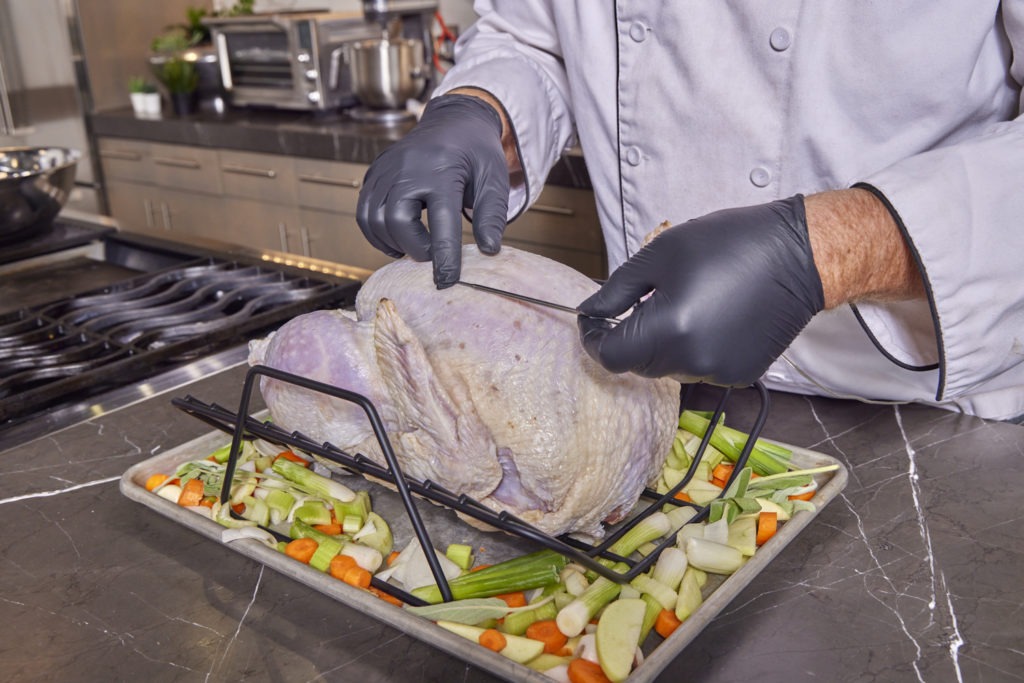
To Place your Probe Correctly, Understand 3 Things:
1. Understand Temperature Gradients
Heat moves. Sounds obvious right? Maybe not. Because of the way that heat is transferred through substances, the outside of a turkey will be at a higher temperature than the inside. This difference in temperature between the exterior and interior of the meat is called a temperature gradient.
When cooking anything, the higher the temperature you cook at, the larger the temperature gradient inside the meat. That is, turkey cooked at 450°F [232°C] will have a larger band of overcooked meat around its edges than turkey cooked at 250°F [121°C].
—The Food Lab’s Step-by-Step Guide to Smoking A Turkey, J. Kenji Lopez-Alt
Understanding temperature gradients leads to understanding proper probe placement: the thermal center.
2. Understand the Thermal Center
The thermal center is the point in any food (including turkey) that is furthest from the exterior of the meat and therefore takes the longest to cook.
The turkey’s breast is the largest mass on the bird, and the center of the breast in its thickest area is where the thermal center will be. This is where the temperature needs to be tracked during the cook because it will be coldest here and your meat is only as done and safe as the lowest temperature found.
3. Understand Your Thermometer’s Probe
For the most accurate probe placement, you need to understand your leave-in thermometer’s probe.
☼ Sensor location
- In the DOT’s probe (or any other Pro-Series probe), the sensor occupies only the very tip (within 1/8 of an inch [.3 cm]) of the end of the probe. A small sensor like that allows you to pinpoint your temperature taking.
☼ Minimum Immersion Depth
•Bi-metallic thermometers (dial thermometers) have a minimum insertion depth of up to 4 inches (10 cm). This is because their sensor is that long. And not only does this mean that incorrectly inserting it won’t get the whole sensor in the bird, it also means that you’ll be taking the average temperature all along the length of that sensor. That’s telling you practically nothing about the thermal center of your turkey. The tiny sensor of our leave-in probes can hit that thermal center almost exactly.

Turkey Cooking Challenges
We all want the same thing on Thanksgiving: a juicy, flavorful, picture-perfect turkey you can be proud to share with your loved ones. But most of us only cook a turkey once a year, making it difficult to get really good at making one in the first place. And cooking a whole turkey is actually a fairly complicated undertaking.
Turkey’s lack of uniformity doesn’t help anything, either! With two kinds of meat and a weird, uneven shape, it can be hard to get it just right. That’s why it’s so important to use your thermometers to cook your turkey. Placing a leave-in probe in the thermal venter of your turkey to track the temperature as you cook will help you get that bird out of the oven before it dries out. And using an instant-read thermometer like Thermapen® ONE to verify the doneness (maybe you didn’t quite hit the thermal center with the probe…) will ensure safety for your family.
So remember, no matter how you cook your turkey, roasted, smoked, deep-fried, or spatchcocked, the first and most important step to getting it just right is getting your probe in the right place.
Learn more about turkey…
Turkey Temperature Tips: The Quest for the Perfect Turkey
Master the critical turkey temperatures and be your family’s Thanksgiving hero this year!
Shop now for products used in this post:
Resources:
The Food Lab’s Guide to Smoking a Turkey, SeriousEats.com, J. Kenji Lopez-Alt


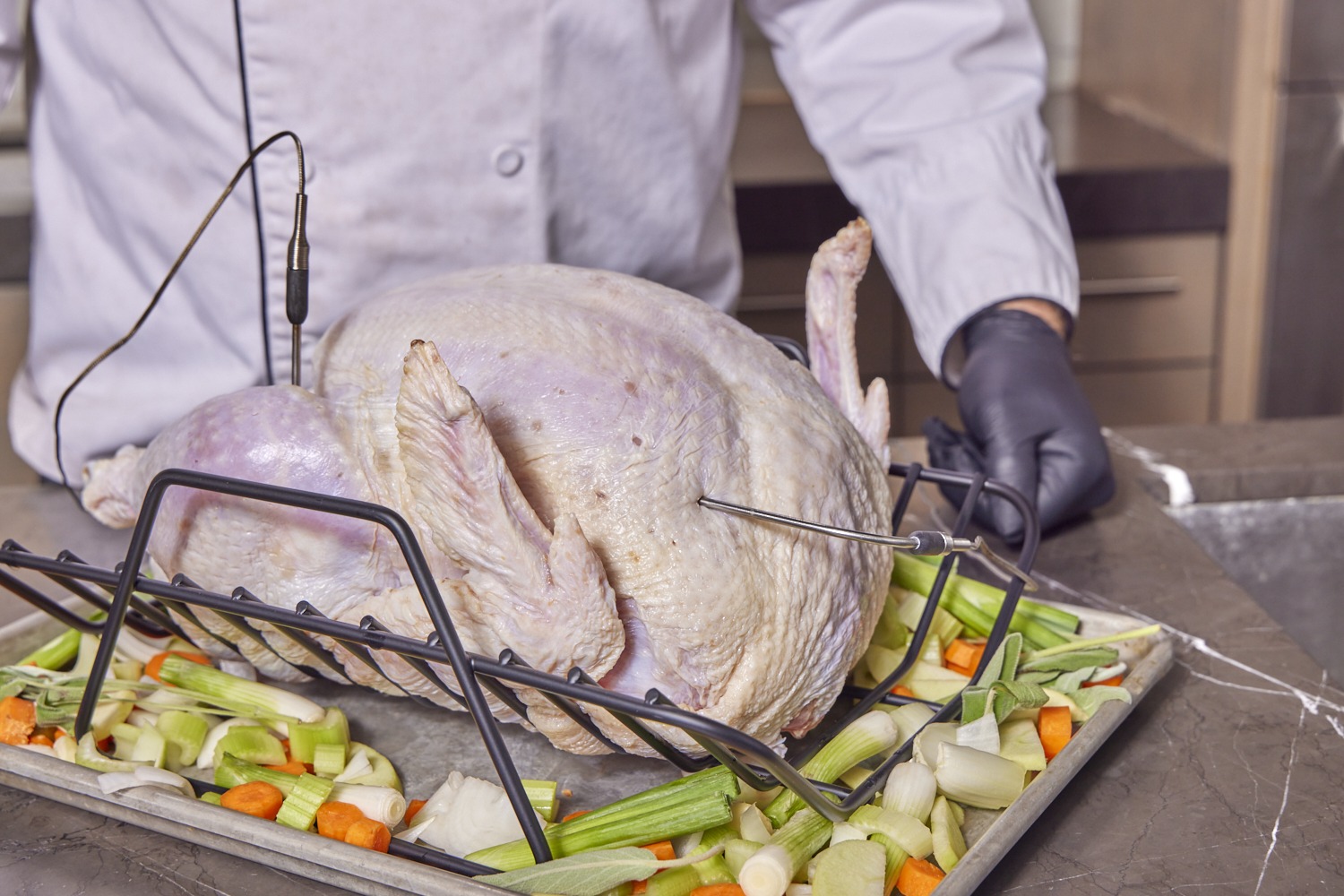
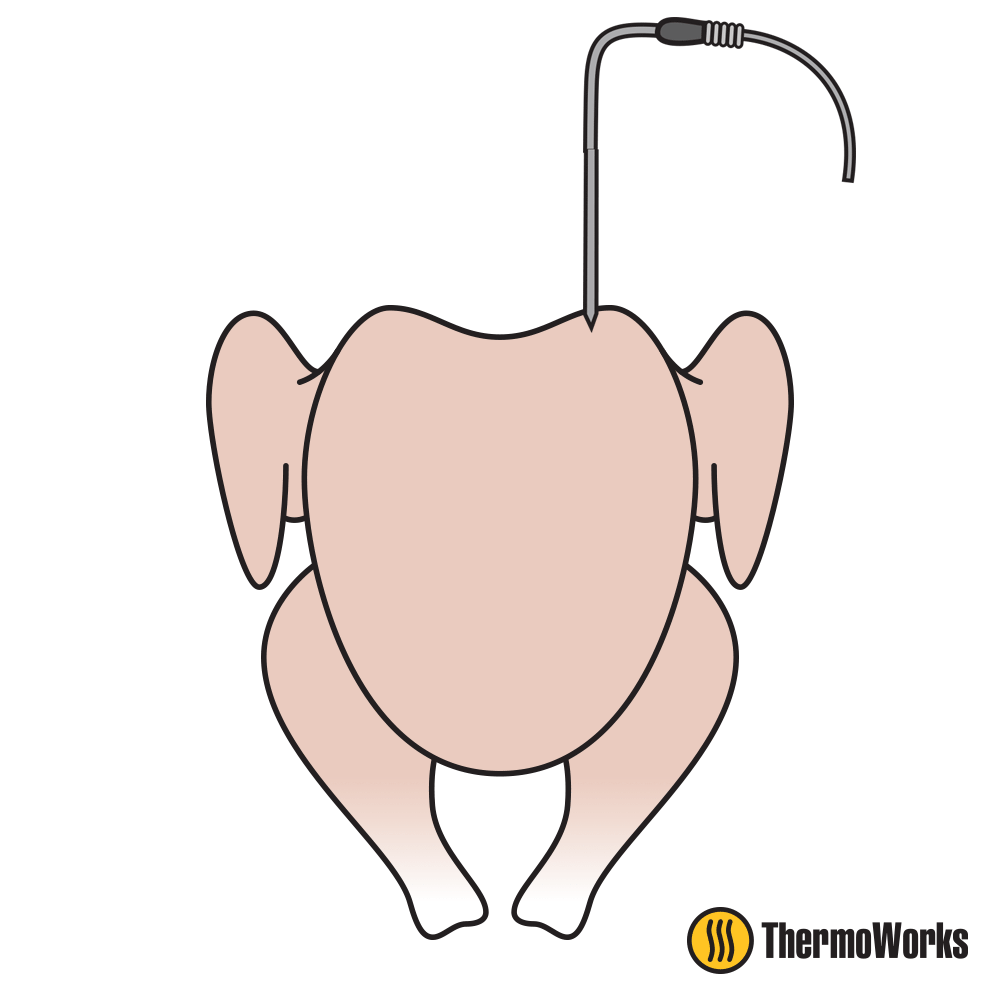 Insert the probe horizontally, from near the neck cavity.
Insert the probe horizontally, from near the neck cavity.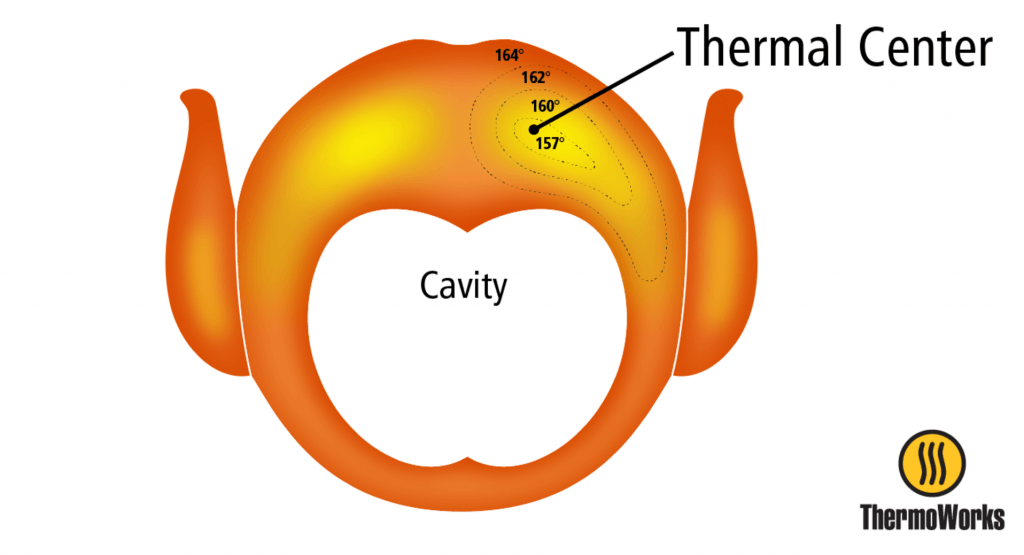


You are correct that there are many different recommended ways to roast a turkey. Please provide your recommended method. Ideally it would be applicable for large and smaller birds, provide the juiciest result, minimize flipping or even rotating the pan, and look beautiful whether stuffed or not. That’s a lot to ask, but attempt to stress at least the first two objectives and provide an explanation of likely results when factors are varied. It seems this would provide a byproduct format to explain how to calibrate ones oven using your instruments, a technique I have followed and loved. Personally I flip and rotate very large fresh birds getting wonderful consistent results, but the older I get (Now 75) the more I would like a simpler method if a good one exists. Thanks.
Herb,
One of our very favorite turkey cooking methods is spatchcocking (this is also a favorite method of many cooking experts). This involves removing the backbone and laying the bird out flat to roast. With the meat in a more uniform layer, the meat cooks faster, and more evenly. You can roast a turkey at 425°F in 45-60 minutes. The meat remains juicy, and the skin is crisp.
The only drawback to this method is that you won’t have a traditional looking whole roasted turkey to present at your holiday table. Check out our post, Spatchcocked: Roast Your Turkey in Record Time! for more information on this method.
You can also give this a try with a whole chicken. The chicken will roast faster since it’s smaller, but the oven temperature and preparation method will remain the same. The key is tracking the internal temperature of the breast to be sure it’s nice and juicy.
We will have more content on turkey cooking as Thanksgiving approaches. Thank you for your question!
-Kim
Cooking in a brown paper bag rubbed down with vegetable oil inside bag thoroughly or using an oil spray (easier). Preheat oven to 500. Place probe in thickest part of breast horizontally. Place Turkey in oven for 1 hour, Lower temp to 400 for 1 hour. Lower temp to 325 until thermometer reads your Turkey is done. Comes out beautifully golden brown and moist.
That’s absolutely stupid.
Paper ignites at 451F!!
Do NOT follow this advice, you will start a fire.
Silicone impregnated “parchment” paper will brown and crisp at 450F, but it is still paper.
Science is better than opinion, because science has been proven true.
Any idea when you will offer a Blue Tooth iOS compatible probe thermometer?
Dwight,
Stay subscribed to our emails so you are the first to hear about exciting new product announcements! Thank you for your question.
-Kim
How do you change your approach when roasting a stuffed bird?
Jack,
Flavorful juices are both a blessing and a curse for stuffing. The juices make the stuffing moist and delicious, but also introduce the possibility of foodborne pathogens. Those pathogens need to come up to 165°F for food safety. What to do?
Kenji has a great method for safely stuffing a turkey, and we have a blog post on the topic. The method involves heating the stuffing before roasting the bird to give it a thermal boost in the oven. If you like crisp stuffing, you can remove it from the turkey after the breast meat has reached it pull temperature, and return the stuffing to the oven to let come up to a food safe temperature of at least 165°F.
Thank you for your question!
-Kim
I know that this is an older post, but I think it’s important to point out a glaring error for those of us who use Celsius.
“Turkey cooked at 450°F [232°C] will have a larger band of overcooked meat around its edges than turkey cooked at 250°F [212°C].”
450°F is indeed close to 232°C, but if you drop the temperature 200°F to 250°F, that does not lead to a 20°C [212°C] drop in temperature!
250°F is much closer to 120°C…
Thanks for the catch! that was a little slip of the dyslexic fingers..It should be 121, not 212!
I will be cooking a 12 pound Turkey in a couple weeks. I am using the ChefAlarm probe Thermometer into the thickest part of the breast. What temperature do I set the LOWEST Alarm and also the HIGHEST Alarm. I am thinking the highest alarm should be set at 165 but what is the lowest alarm setting to be? Thank you!!
I’d set my highest alarm to 157°F (you can read about why that temperature is safe in this post about chicken temperatures). You needn’t worry about the low alarm, per se, unless you want the turkey to cool to a certain point before you serve it. If that were the case, you could set it for, maybe, 120°F and when the turkey comes down to that temperature you’ll get an alarm. But I would not worry about that. The low alarm is most often used for cooling or chilling things. So when I cook my turkey with it, I usually just set it to a temperature that won’t get in the way—say, 30°F.
155 is fine. That’s what world renown Chef Jean Pierre suggests.
What about probe placement in the thigh? The illustration is great for the breast, but a similar one for thigh placement would be super helpful!
Just try to get it in deep in the meet but not on a bone.